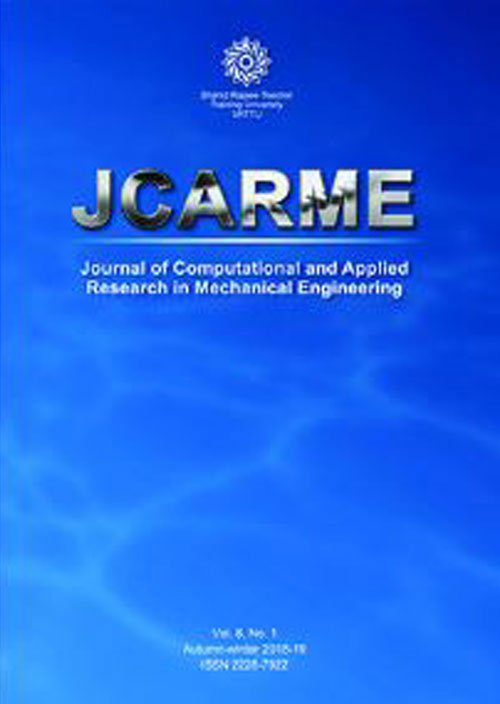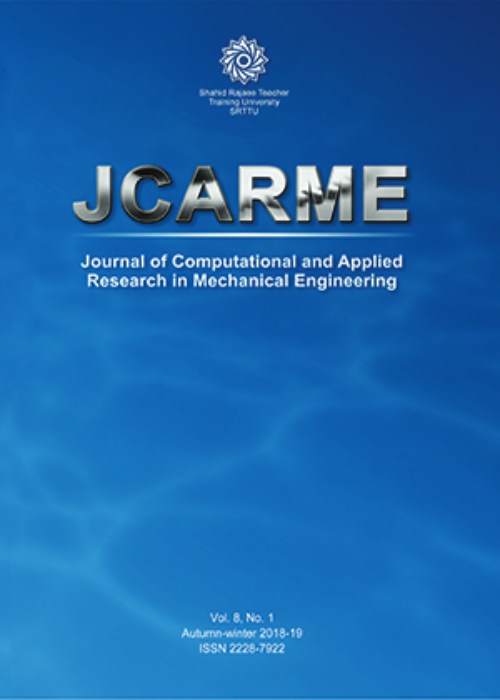فهرست مطالب

Journal of Computational and Applied Research in Mechanical Engineering
Volume:11 Issue: 2, Winter-Spring 2022
- تاریخ انتشار: 1400/12/15
- تعداد عناوین: 10
-
-
Pages 279-295The paper investigates the temperature effect on water hammers in an isothermal pressurized copper pipe rig, for single and two-phase flows. The study concerns pressure wave’s intensity, celerity, and attenuation. Also, the volume of cavities created during low-pressure periods is inspected. The mathematical model of hyperbolic equations is described by the dynamic and continuity equations, which have been transformed by the characteristics method into ordinary differential equations. Water hammer solver was built considering two different models of cavitation and column separation, the discrete vapor cavity model and the discrete gas cavity model. In addition to the quasi-steady friction model, two unsteady friction models were incorporated into the code, the convolution-based model proposed by Vardy and Brown and the instantaneous acceleration model proposed by Brunone. The simulations concern temperature range within 4°C to 95°C. Although the single and the two-phase water hammers don’t behave in the same manner, the results obtained with the different models, show a significant influence of the temperature.Keywords: Hydraulic transient, Water hammer, Cavitation, Column separation, Unsteady flow
-
Pages 297-315Studying the behavior of sandwich panels is very important due to their widespread use in different industries. Therefore, over the past decades, various theories have been proposed to study the behavior of these panels. In this paper a higher order global-local theory with 3D equilibrium-based corrections is presented to study behavior of thick and thin sandwich plate with flexible and auxetic core. In addition to correcting the results with 3D elasticity equations, another important advantage of the presented theory is the ability to consider the transverse core deformation of the sandwich panels. It should be mentioned that to study the behavior of thick sandwich panels, especially with soft core, the existence of this feature is very necessary and has a great effect on the accuracy of the obtained results. Comparison of the obtained results with those existing in valid references showed that the formulation of the provided finite element had a very good accuracy even for thick and thin sandwich plates. Finally, the effect of different material and geometrical parameters on the behavior of sandwich plates are carefully investigated using the presented theory.Keywords: Sandwich plate, Global-local theory, Higher order theory, Flexible core, Auxetic foam
-
Pages 317-327Theoretical investigation of Ohmic heating (Joule heating) and radiation on MHD Jeffery fluid model with porous material along the tapered channel with peristalsis is the focus of this study. Long wavelength and low-Reynolds number approximations are used in the mathematical modelling. Axial rate, pressure gradient, temperature, and heat transfer coefficient rate expressions are calculated. Plotting diagrams were used to analyse the impact of physical parameters on flow characteristics, which were then addressed in greater depth. It is worth noting that raising the gravitational parameter, Jeffery fluid parameter, Hartmann number and Porosity parameter raises the fluid’s velocity. Also, as the Ohmic heating (Jeffery fluid) parameter and porosity parameter increase, the axial pressure gradient drop;, and the temperature of the fluid rises. The rate of heatt transfer coefficient rises in region with an increase in the Radiation parameter, Heat generator parameter and Jeffery fluid parameter. Mathematica software is employed to seek out numerical results.Keywords: Ohmic heating, Gravity field, MHD, Jeffery fluid, Tapered vertical channel
-
Pages 329-338In this paper, the crack propagation and branching in the pre-cracked and notched samples have been modeled using nonlocal peridynamic theory. The bond-based peridynamic model has been numerically implemented which make it possible to simulate various features of dynamic brittle fracture such as crack propagation, asymmetries of crack paths and successive branching. The fracture simulation of thin plates made of a brittle material with different crack and notch patterns has been considered. The molecular dynamics open-source free LAMMPS code has been updated to implement the peridynamic theory based modeling tool for two-dimensional numerical analysis. The simulations show that, the simulation time significantly decreases which is the core and distracting deficiency of the peridynamic method. Moreover, the simulated results demonstrate the capability of peridynamic theory to precisely predict the crack propagation paths as well as crack branching during dynamic fracture process. The good agreement between simulation and experiments is achieved.Keywords: Peridynamic Theory, Brittle Fracture, Crack Branching, Thin Plate
-
Pages 339-349
This study emphasizes the upshots of non-linear radiation and electrical resistance heating on a three dimensional Jeffrey dissipating nanoflow in view of convective surface conditions. The initial set of nonlinear dimensional boundary layer equations are transformed into a system of ordinary differential equations with suitable similarity variables and then solved by shooting method using Mathematica software. For various representative quantities, the behavior of the momentum, energy and species diffusion along with engineering quantities near the surface are figured for different estimations of the fluid properties. The examination of the present outcomes has been made with the existing work which is in good agreement. This study helps in understanding that the heat transfer rate is predominant in the non-linear radiation compared to linear radiation. Jeffrey fluid model has the capacity of describing the stress relaxation property, that usually viscous fluid lags and this is exhibited clearly in the study. Shear stress descends as the fluid pertinent parameter ascends.
Keywords: Magnetic field, Jeffrey nanofluid, Non-linear radiation Ohmic Heating, Stretching surface, Surface convection, Viscous dissipation -
Pages 351-364
In this paper, a quadrotor with two manipulators constrained on a straight path is modeled and a robust adaptive controller is proposed for it. Adding two manipulators to quadrotor increases its capabilities and applications in industry. Here, these two manipulators are used to place the robot on a constraint path so that the quadrotor can perform monitoring operations more accurately, since the under-actuated quadrotor becomes over-actuated by these constrained manipulators and one can use this feature to accurately control the position of the robot. Reduced form of motion equations is derived for the constrained quadrotor and based on this a robust adaptive controller is proposed. The nonlinear terms in the dynamic model are approximated by basic functions with constant weights; and adaptive laws are designed by projection operator. Stability analysis is performed based on the Lyapunov theory. Evaluation of the presented controller is done by some numerical simulations. The simulation results showed that the robot tracks the reference path with bounded error in spite of dynamic uncertainties and wind force; and satisfies the considered constraints.
Keywords: Constrained quadrotor, Robust adaptive control, Functional approximation technique, Projection operator, Wind force -
Pages 365-379This paper presents closed-form formulations of higher order shear deformation theory (HSDT) to analyse the functionally graded plates (FGPs) acted upon a thermo-mechanical load for simply supported (SS) conditions. This theory assumes nullity conditions for transverse stress on bottom and top face of the FGPs. Moreover, it considers the influence of both stresses and strains in the axial and transversal direction. In these improvements, an accurate parabolic variation is assumed in the thickness direction for transverse shear strains. Therefore, this theory omits the use of correction factor for accurately estimating the shear stress. The physical properties of the FGPs are considered to change along the thickness using a power law. The equilibrium relations and constraints on all edges are attained by considering the virtual work. Numerical evaluations are attained based on Navier’s approach. The exactness and consistency of the developed theory are ascertained with numerical results for deflections and stresses of SS FGPs; and it is deemed that numerical solutions for thermo-mechanical load will utilize as a reference in the future.Keywords: Functionally graded plates, Power law distribution, Navier’s Method, Principle of virtual work, HSDT, Thermo-mechanical loading
-
Pages 381-395This paper presents closed-form formulations of higher order shear deformation theory (HSDT) to analyse the functionally graded plates (FGPs) acted upon a thermo-mechanical load for simply supported (SS) conditions. This theory assumes nullity conditions for transverse stress on bottom and top face of the FGPs. Moreover, it considers the influence of both stresses and strains in the axial and transversal direction. In these improvements, an accurate parabolic variation is assumed in the thickness direction for transverse shear strains. Therefore, this theory omits the use of correction factor for accurately estimating the shear stress. The physical properties of the FGPs are considered to change along the thickness using a power law. The equilibrium relations and constraints on all edges are attained by considering the virtual work. Numerical evaluations are attained based on Navier’s approach. The exactness and consistency of the developed theory are ascertained with numerical results for deflections and stresses of SS FGPs; and it is deemed that numerical solutions for thermo-mechanical load will utilize as a reference in the future.Keywords: Natural frequency, Thin Walled, Cylindrical Tanks, Internal Support, Composite Material
-
Pages 397-407The new and advance technologies for higher performance and lower maintenance are required to operate gas turbines at higher operating temperatures. Higher turbine inlet temperature results in higher blade metal temperatures. These variations in temperatures of the blade material must be limited such that the blades have a sufficient life span. To make blade material temperature within the limits, the coolant air is bled from the compressor to protect the outer surface of the turbine blade from the hot gases. The purpose of this study is to investigate the cooling performance of a blade with leading edge cooling holes. The numerical simulation approach using ANSYS Fluent has been considered. The analysis is performed by taking different hole geometries namely cylindrical (model 1) and tapered (model 2) on the leading edge of the turbine blade for different blowing ratios. The analysis also compares the cooling effectiveness of the blade for two different coolants namely air and nitrogen. The results show that for highest effectiveness hole (E3 hole), Model 1 and Model 2 comparison suggest that Model 1 has 1.2% more cooling effectiveness for air as coolant. For E3 hole, the comparison of Model 1 between two coolants show that film cooling effectiveness of the air gives 0.6% more film cooling effectiveness compared to nitrogen. The presented work helps researchers and blade manufacturers to select the correct hole geometry, coolant type, and determine the best blowing ratio to improve the film cooling efficiency of gas turbine blades with leading edge holes.Keywords: Blowing ratios, Coolant density, Cooling performance, Numerical Approach, Gas turbine blade, Hole geometry
-
Pages 409-423Recognizing a driver’s braking intensity plays a pivotal role in developing modern driver assistance and energy management systems. Therefore, it is especially important to autonomous and electric vehicles. This paper aims at developing a strategy for recognizing a driver’s braking intensity based on the pressure produced in the brake master cylinder. In this regard, a model-based, synthetic data generation concept is used to generate the training dataset. This technique involves two closed-loop controlled models: an upper-level longitudinal vehicle dynamics model and a lower-level brake hydraulic dynamic model. The adaptive particularly tunable fuzzy particle swarm optimization algorithm is recruited to solve the optimal K-means clustering. By doing so, the best number of clusters and positions of the centroids can be determined. The obtained results reveal that the brake pressure data for a vehicle traveling the new European driving cycle can be best partitioned into two clusters. A driver’s braking intensity may, therefore, be clustered as moderate or intensive. With the ability to automatically recognize a driver’s pedal feel, the system developed in this research could be implemented in intelligent driver assistance systems as well as in electric vehicles equipped with intelligent, electromechanical brake boosters.Keywords: Vehicle safety systems, Clustering, K-means Algorithm, Hydraulic brake system


